Certains lecteurs nous ont demandé comment désactiver la barre d'administration WordPress. Bien qu'il s'agisse d'une petite modification, certains utilisateurs préfèrent le faire pour diverses raisons, telles que le maintien d'une interface utilisateur plus propre ou l'amélioration de l'expérience utilisateur pour les utilisateurs non administrateurs.
Par défaut, vous pouvez facilement désactiver la barre d'administration WordPress pour les utilisateurs individuels. Cependant, cela peut prendre beaucoup de temps si vous avez un grand nombre d'utilisateurs enregistrés sur votre site.
Dans cet article, nous vous montrerons comment désactiver facilement la barre d'administration WordPress pour tous les utilisateurs, à l'exception des administrateurs.
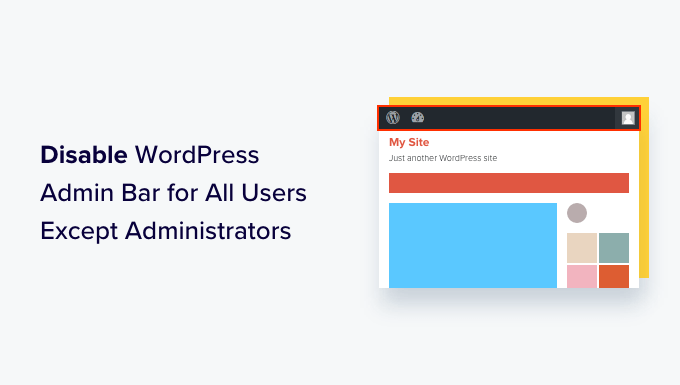
Qu'est-ce que la barre d'administration WordPress ?
Par défaut, WordPress affiche une barre d'administration en haut de l'écran pour tous les utilisateurs connectés. Lorsque vous êtes connecté à votre compte, vous pouvez voir cette barre d'outils dans la zone d'administration WordPress et sur toutes les autres pages.
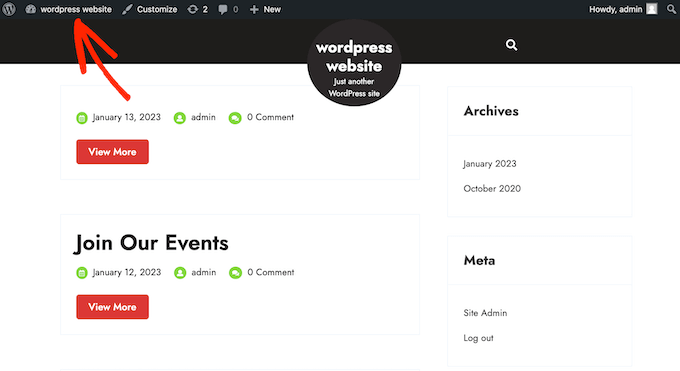
La barre d'outils d'administration WordPress contient des raccourcis utiles vers différentes zones du backend de WordPress, et ces raccourcis changent en fonction du rôle et des autorisations d'un utilisateur dans WordPress.
Cependant, la barre d'administration peut être distrayante lorsque vous regardez le front-end de votre site Web.
Elle peut également affecter la conception et l'expérience utilisateur de votre site Web. Cela peut poser problème si vous créez ou gérez un site WordPress pour un tiers, car cela l'empêche de voir à quoi ressemble réellement son site Web.
Heureusement, il existe plusieurs façons de désactiver la barre d'administration pour tous les utilisateurs, à l'exception des administrateurs. Utilisez simplement les liens rapides ci-dessous pour accéder à la méthode que vous souhaitez utiliser :
- Méthode 1 : Modifier les autorisations de chaque utilisateur dans WordPress
- Méthode 2 : Utiliser du code pour désactiver la barre d'administration pour les utilisateurs non administrateurs (recommandé)
- Méthode 3 : Utiliser un plugin gratuit pour désactiver la barre d'administration pour les utilisateurs non administrateurs
Tutoriel vidéo
Si vous préférez des instructions écrites, continuez à lire.
Méthode 1 : Modifier les autorisations de chaque utilisateur dans WordPress
Vous pouvez désactiver la barre d'administration pour des utilisateurs spécifiques en modifiant simplement leur profil utilisateur. C'est une méthode rapide et facile si vous avez juste besoin de supprimer la barre pour un petit nombre de personnes. Cependant, si vous gérez un site d'adhésion avec de nombreux utilisateurs, nous vous recommandons de choisir une autre méthode.
Pour supprimer la barre d'administration manuellement, allez simplement sur la page Utilisateurs » Tous les utilisateurs dans le tableau de bord d'administration de WordPress. Ensuite, survolez l'utilisateur WordPress qui n'a pas besoin de la barre d'administration, et cliquez sur « Modifier » lorsqu'elle apparaît.
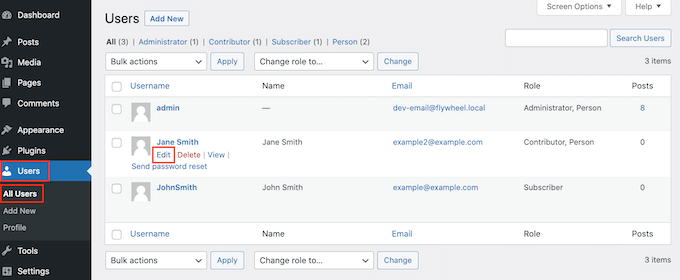
Cela ouvrira le profil de cet utilisateur.
À partir de là, décochez la case à côté de l'option « Afficher la barre d'outils lors de la visualisation du site ».
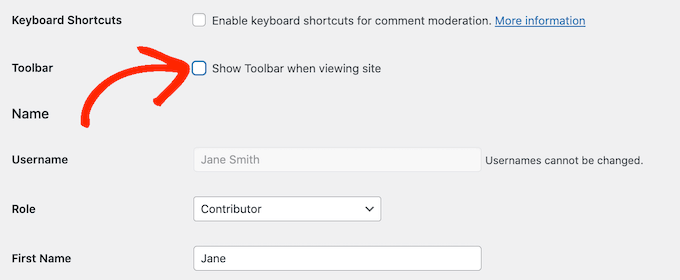
Ensuite, faites défiler jusqu'en bas de l'écran et cliquez sur « Mettre à jour l'utilisateur » pour enregistrer vos modifications. Cela désactivera la barre d'administration pour cette personne spécifique uniquement.
Pour masquer la barre d'outils pour plus d'utilisateurs, suivez simplement le même processus décrit ci-dessus.
Méthode 2 : Utiliser du code pour désactiver la barre d'administration pour les utilisateurs non administrateurs (recommandé)
Si vous avez besoin de masquer la barre d'administration pour de nombreuses personnes différentes, modifier manuellement les paramètres de chaque utilisateur prendrait beaucoup de temps et d'efforts.
Pour cette raison, nous recommandons de désactiver la barre d'administration en ajoutant du code au fichier functions.php, qui est un fichier de thème WordPress.
Certains guides vous diront de modifier manuellement les fichiers du thème, mais cela peut causer des erreurs WordPress courantes et même casser complètement votre site web.
Pour cette raison, nous recommandons d'utiliser WPCode. C'est le meilleur plugin de snippets de code et il permet d'ajouter facilement du code personnalisé dans WordPress sans mettre votre site en danger.
Nous avons utilisé WPCode pour changer la palette de couleurs de l’administration, supprimer le texte ‘Bonjour Administrateur’, désactiver le bouton Options de l’écran, et plus encore.
Tout d’abord, vous devrez installer et activer le plugin gratuit WPCode. Pour plus d’informations, consultez notre guide étape par étape sur comment installer un plugin WordPress.
Une fois le plugin activé, allez dans Extraits de code » Ajouter un extrait.
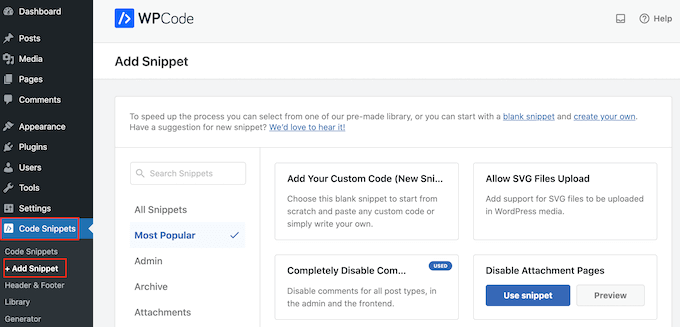
Ici, vous verrez tous les extraits de code pré-faits que vous pouvez ajouter à votre site.
En fait, WPCode possède l’extrait de code exact dont vous avez besoin pour désactiver la barre d’administration dans sa bibliothèque d’extraits intégrée. Allez simplement dans Extraits de code » Bibliothèque.
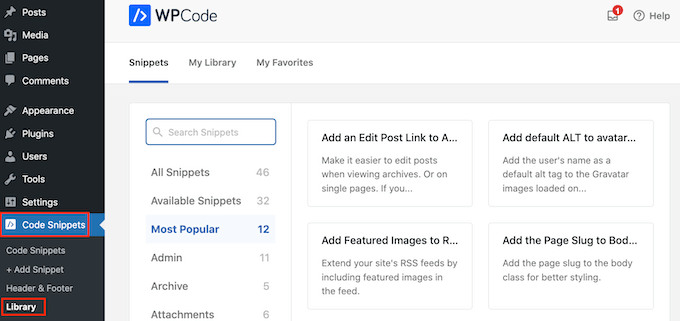
Ici, recherchez ‘Désactiver la barre d’administration WP’.
Lorsque le bon extrait apparaît, cliquez simplement sur son bouton ‘Utiliser l’extrait’.
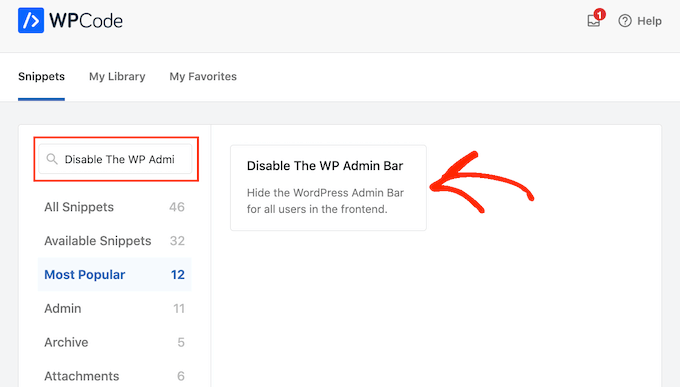
Le plugin ajoutera automatiquement le code à votre site, donnera un titre descriptif au code, choisira la méthode d’insertion correcte et ajoutera même des étiquettes pour vous aider à identifier l’extrait.
Voici à quoi ressemble le code :
/* Disable WordPress Admin Bar for all users */
add_filter( 'show_admin_bar', '__return_false' );
Maintenant, si votre objectif est de désactiver la barre d'administration pour tous les utilisateurs, il vous suffit de faire basculer le commutateur de « Inactif » à « Actif », puis de cliquer sur « Mettre à jour ».
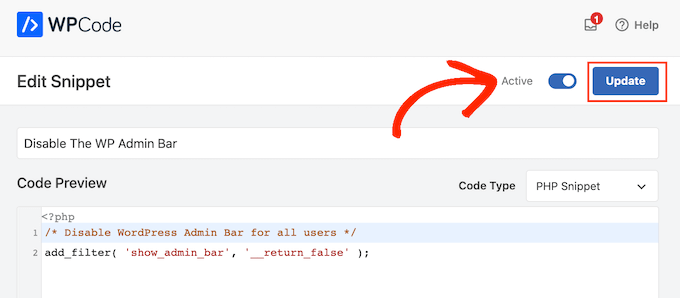
Cependant, puisque notre objectif est de désactiver la barre d'administration WordPress pour les utilisateurs non administrateurs, nous devons apporter quelques petites modifications au code.
Vous pouvez remplacer le code existant par le suivant :
/* Disable WordPress Admin Bar for all users except administrators */
add_filter( 'show_admin_bar', 'restrict_admin_bar' );
function restrict_admin_bar( $show ) {
return current_user_can( 'administrator' ) ? true : false;
}
Ce code identifie tous les utilisateurs non administrateurs qui ne consultent pas actuellement le tableau de bord d'administration. Pour ces utilisateurs, il désactive la barre d'administration WordPress.
Après cela, faites défiler la page jusqu'à la section « Insertion ». Ici, vous pouvez conserver la méthode par défaut « Insertion automatique » pour vous assurer que le code s'exécute partout.
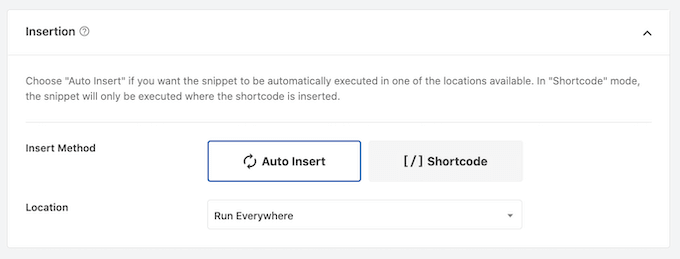
Enfin, faites défiler jusqu'en haut de l'écran et cliquez sur le curseur « Inactif » pour qu'il affiche « Actif ».
Ensuite, cliquez simplement sur le bouton « Enregistrer le snippet » ou « Mettre à jour » pour rendre le snippet de code actif.
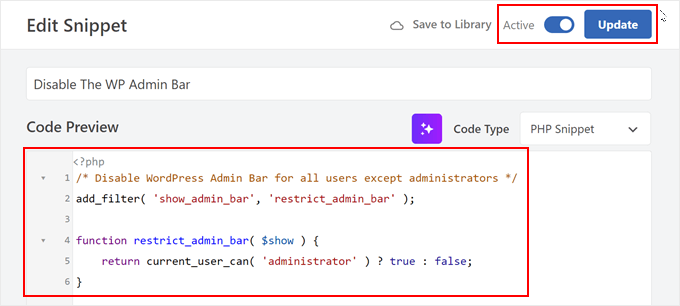
C'est tout ! N'oubliez pas de vérifier votre site Web WordPress pour vous assurer que tout fonctionne correctement.
Méthode 3 : Utiliser un plugin gratuit pour désactiver la barre d'administration pour les utilisateurs non administrateurs
Si vous ne souhaitez pas ajouter de code à votre site Web, vous pouvez masquer la barre d'administration à l'aide d'un plugin. Hide Admin Bar Based on User Roles vous permet de supprimer la barre d'outils en fonction des différents rôles d'utilisateur, c'est donc un bon choix si vous souhaitez désactiver la barre pour tous les membres, les clients WooCommerce, ou un autre rôle d'utilisateur.
Tout d'abord, vous devez installer et activer le plugin Hide Admin Bar Based on User Roles. Pour plus de détails, consultez notre guide étape par étape sur comment installer un plugin WordPress.
Après l'activation, vous devez vous rendre sur la page Paramètres » Paramètres de masquage de la barre d'administration. À partir de là, cochez les cases à côté des rôles d'utilisateur pour lesquels vous souhaitez désactiver la barre d'administration.
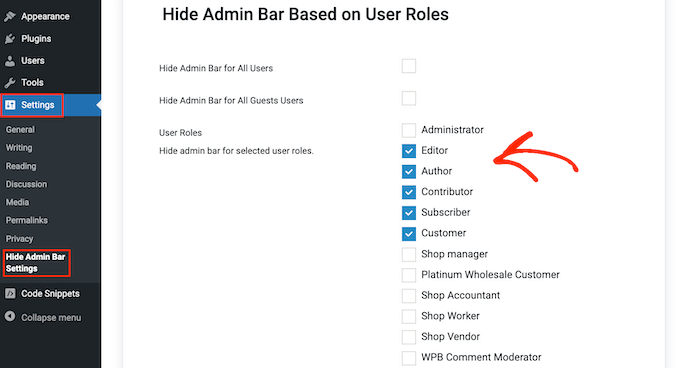
Une fois cela fait, cliquez simplement sur « Enregistrer les modifications » pour sauvegarder vos paramètres.
Nous espérons que cet article vous a aidé à apprendre comment désactiver la barre d'administration WordPress pour tous les utilisateurs sauf les administrateurs. Vous voudrez peut-être aussi consulter notre guide sur comment recevoir des notifications par e-mail pour les modifications de publication dans WordPress et nos meilleurs choix de meilleurs plugins de journal d'activité et de suivi WordPress.
Si cet article vous a plu, abonnez-vous à notre chaîne YouTube pour des tutoriels vidéo WordPress. Vous pouvez également nous retrouver sur Twitter et Facebook.





Jiří Vaněk
C'est vraiment très utile pour un site web avec plusieurs auteurs. Je l'ai appliqué presque immédiatement après en avoir lu. Je n'avais pas prêté beaucoup d'attention à ce problème auparavant, mais comme je viens de terminer un site web avec plusieurs auteurs, ce tutoriel était très opportun, et une fois de plus, vous m'avez conduit à une modification intéressante qui améliore la sécurité.
Livingstone
Provoque une erreur lors de l'activation
Support WPBeginner
It would depend on what method you are using as well as the error for us to be able to assist. If you reach out using our contact form our support team should be able to assist you further
Admin
Dayo Olobayo
Merci pour l'article, mais y a-t-il un moyen de styliser la barre d'administration à ma guise ?
Support WPBeginner
Pour cela, nous vous recommandons de consulter notre article ci-dessous !
https://www.wpbeginner.com/beginners-guide/how-to-customize-wordpress-admin-area-dashboard-for-beginners/#customizeadmintoolbar
Admin
Hajjalah
J'ai un plugin Questions et Réponses sur mon blog qui ajoute automatiquement une barre d'administration pour tous les utilisateurs chaque fois que je le mets à jour. Je suis heureux que WPCode ait complètement désactivé cette fonctionnalité agaçante. Merci WPBeginner pour cet article utile.
Support WPBeginner
De rien !
Admin
Moinuddin Waheed
Ceci est très nécessaire pour masquer la barre d'administration à tous les utilisateurs, à l'exception de l'administrateur.
J'ai pensé à faire cela plusieurs fois, surtout lorsque je gérais un site d'actualités et que j'avais de nombreux auteurs et contributeurs.
Leur montrer la barre d'administration n'est pas seulement inutile, mais aussi ennuyeux.
J'apprécie vraiment les étapes pour se débarrasser de cette barre d'administration et la réserver uniquement à l'administrateur.
Amos Showole
Wow… C'est génial, vous avez résolu un problème que j'avais sur l'un de mes sites WordPress sur lequel BuddyPress était installé….
Support WPBeginner
Heureux d'apprendre que notre guide vous a été utile !
Admin
Hussam H
Merci et que Dieu vous bénisse.
Support WPBeginner
De rien !
Admin
Paul
L'utilisation du hook after_setup_theme ne fonctionne pas toujours. Essayez ceci à la place :
function remove_admin_bar( $value ) { return ( current_user_can( ‘administrator’ ) ) ? $value : false; } add_filter( ‘show_admin_bar’ , ‘remove_admin_bar’);
Matthew D Henderson
Merci de proposer quatre façons différentes de faire cela. Parfait
Support WPBeginner
Glad you found our recommendations helpful
Admin
Joey
Quel serait le code si je voulais ajouter Éditeur et Administrateur pour afficher la barre d'administration..
if (!current_user_can(‘administrator’) && !is_admin())…
if (!current_user_can(‘editor’) && !is_editor())…
serait-ce if (!current_user_can(‘administrator’) && !is_admin() || !current_user_can(‘editor’) && !is_editor())
est-ce que cela fonctionnerait ?
Support WPBeginner
Pour ce que vous voulez, vous voudriez supprimer : && !is_editor()
Ensuite, cela devrait fonctionner comme vous le souhaitez.
Admin
Basia
Salut,
Je cache la barre d'administration avec le plugin que vous recommandez, mais lorsqu'un abonné se connecte, il peut toujours cliquer sur « voir mon profil » et voir le tableau de bord wp. Puis-je désactiver cela ?
Support WPBeginner
Vous pouvez rediriger les utilisateurs après la connexion en utilisant la méthode de notre guide ci-dessous :
https://www.wpbeginner.com/plugins/how-to-redirect-users-after-successful-login-in-wordpress/
Admin
Deewinc
Merci pour l'article mais la méthode 3 ne fonctionne pas.
Support WPBeginner
Si la méthode 3 ne fonctionne pas pour vous, nous vous recommandons d'essayer l'une des autres méthodes pour tester.
Admin
Dipesh Vedak
et si le thème est mis à jour ?
Support WPBeginner
Si vous avez créé un plugin spécifique au site, il resterait.
Admin
Brandon Porter
Ça a marché à merveille. Merci !
Support WPBeginner
You’re welcome, glad our guide was helpful
Admin
Bryan E Jackson
Doesn’t seem to work for my Divi Theme
Support WPBeginner
Vous voudrez peut-être essayer de vider votre cache, c'est la raison la plus courante pour laquelle le changement n'est pas visible.
Admin
Paul
Qu'est-ce que cela désactive exactement ? Je vois toujours une barre d'administration et j'ai accès aux options du menu lorsque je vais sur exemple.com/wp-admin lorsque je suis connecté en tant qu'abonné.
Support WPBeginner
Vous voudrez vous assurer que le code a été correctement ajouté, car c'est la cause la plus probable du non-masquage de la barre d'administration. Sinon, vous pourriez également avoir un plugin qui remplacerait ce code.
Admin
Jürgen
Merci. Exactement ce dont j'avais besoin
Support WPBeginner
Glad our guide was helpful
Admin
khaoula
Merci beaucoup, mais que faire si l'utilisateur veut se déconnecter ?
Support WPBeginner
Vous pouvez ajouter un lien de déconnexion à votre menu pour une option, nous avons un guide sur la façon de le faire ci-dessous.
https://www.wpbeginner.com/wp-tutorials/how-to-add-the-wordpress-logout-link-to-navigation-menu/
Admin
Kaetech
Merci beaucoup. Exactement ce dont j'avais besoin. Ça a fonctionné.
Support WPBeginner
You’re welcome, glad our guide was helpful
Admin
Marc Korden
Impossible d'ajouter le code d'administration dans mon thème :
Communication avec le site impossible pour vérifier les erreurs, l'ajustement PHP a été annulé. Le changement du fichier PHP doit être effectué d'une autre manière, par exemple en utilisant SFTP.
Support WPBeginner
Ce message signifie que WordPress n'a pas pu vérifier les erreurs dans le code et que vous devrez utiliser un outil FTP pour ajouter le code. Nous avons un guide que vous pouvez suivre ci-dessous :
https://www.wpbeginner.com/beginners-guide/how-to-use-ftp-to-upload-files-to-wordpress-for-beginners/
Admin
Jailson Pacagnan Santana
Merci ! Que Dieu vous bénisse
Support WPBeginner
You’re welcome, glad our guide was helpful
Admin
Ciao
Où dois-je insérer le code exactement, au début, à la fin de functions.php ? Merci
Support WPBeginner
Nous recommandons normalement de le mettre à la fin pour qu'il soit facile à trouver et à supprimer si nécessaire
Admin
Agha Mubasher
Hello there…!
First of all i simply love the work wpbeginner, as you always bring forward the simplest solutions to our wordpress issues. Your website and Youtube channel has always been helpful for me. Thumbs Up for that..
J'ai eu un problème pour masquer la barre d'administration uniquement pour les abonnés. Maintenant, après avoir appliqué votre code dans le fichier function.php, elle est également masquée pour mes éditeurs.
Y a-t-il un moyen pour que mes éditeurs puissent également voir la barre d'administration et qu'elle ne soit masquée que pour les abonnés..!!
Support WPBeginner
Pour cela, vous devrez cibler une autre permission que votre éditeur possède au lieu de celle que nous ciblons, comme edit_others_posts
Admin
Felix
Thank you very much.
Support WPBeginner
You’re welcome
Admin
Dana Jewel
Merci ! Ce extrait a été vraiment, vraiment utile.
Support WPBeginner
You’re welcome, glad our guide could be helpful
Admin
Faris
Super aide, ça a marché à merveille !
Merci beaucoup.
Support WPBeginner
You’re welcome
Admin
Jesaja
Sur mon site web, il est indiqué :
« Impossible de communiquer avec le site pour vérifier les erreurs fatales, le changement PHP a donc été annulé. Vous devrez télécharger votre modification de fichier PHP par un autre moyen, par exemple en utilisant SFTP. »
Que faire maintenant ?
Support WPBeginner
Cela signifie que les nouvelles fonctionnalités de sécurité de WordPress vous ont empêché de modifier le fichier, vous devrez télécharger et modifier les fichiers de votre thème en utilisant FTP : https://www.wpbeginner.com/beginners-guide/how-to-use-ftp-to-upload-files-to-wordpress-for-beginners/
Admin
Jesaja
Oh... je ne peux pas juste le mettre dans la zone CSS personnalisé ?
Support WPBeginner
Non, c'est du PHP, pas du CSS, donc ça n'irait pas là.
TaiRon
Cela fonctionne comme une chame, votre code est parfait mais je dois changer directement dans le gestionnaire de fichiers.
Merci.
Support WPBeginner
You’re welcome, glad our guide could help
Admin
Bongani
Merci, tutoriel très utile
Support WPBeginner
You’re welcome
Admin
Mike
Merci !
Support WPBeginner
You’re welcome
Admin
Jim
Ce code peut-il être modifié pour autoriser la barre d'administration WordPress pour les administrateurs ET les modérateurs, mais la cacher pour tous les autres ?
Merci !
Support WPBeginner
Vous devrez ajouter un autre && !current_user_can('') à l'intérieur des parenthèses avec le nom du rôle pour lequel vous souhaitez qu'il apparaisse ou utiliser le plugin adminimize de notre article : https://www.wpbeginner.com/wp-tutorials/what-everybody-ought-to-know-about-the-wordpress-admin-bar/
Admin
Andreas
Si un utilisateur connaît la structure d'URL de WordPress, il peut facilement naviguer vers /wp-admin/ et là, la barre d'administration sera visible. De plus, le moyen le plus simple est de la désactiver dans les paramètres de l'utilisateur si vous avez un petit nombre d'utilisateurs.
Adam Pressman
Ne fonctionne pas. Eh bien, pour être juste, cela fonctionne lorsque vous l'utilisez pour la première fois, mais ensuite quelque chose se passe et cela ne fonctionne plus. rien ne remplace le functions.php et le code est là, mais généralement après le premier cycle de connexion/déconnexion, une connexion ultérieure verra la barre d'administration revenir.
prashanth
Cela fonctionne mais l'utilisateur ne peut pas se déconnecter. Comment se déconnecter ?
Cesar
J'ai créé un site de médias sociaux en utilisant plusieurs plugins et tout fonctionne bien sauf pour un problème. Les pages sont correctement restreintes et redirigées (pages Buddypress, blogs, etc.) pour les utilisateurs non connectés.
Cependant, le principal problème que j'ai est que les utilisateurs non connectés peuvent toujours accéder aux articles de blog et aux pages de profil utilisateur via des widgets placés sur la barre latérale et le pied de page et je ne trouve aucune solution.
Des idées sur la question, des plugins ou du code que je peux insérer dans le thème enfant ?
Je cherche une solution depuis plus d'une journée et tout ce qu'il y a, c'est comment restreindre les pages et le contenu partiel, mais rien ne fonctionne sur les liens des widgets, ils continuent de passer outre les restrictions en place.
Merci
Support WPBeginner
Salut Cesar,
Il existe plusieurs widgets et plugins qui vous permettent de masquer les widgets aux utilisateurs non connectés. Cependant, si les utilisateurs non connectés connaissent l'URL, ils pourront toujours accéder directement à ces URL. Vous devez examiner les paramètres de votre plugin et voir si vous pouvez trouver l'option pour masquer les pages de profil aux utilisateurs non connectés.
Admin
Shabz
This code or several others that I tried from the comments isn’t working. I’m trying to remove that dumb silver/black wordpress tab above my menu that shows up for all of my website’s users. How do I remove that? Please help
Humberto Buitrago
Existe-t-il un plugin que nous pouvons utiliser à la place du code ?
Merci d'avance !
Jack Hernandez
Comme mentionné dans l'article, vous avez inclus un moyen pour les utilisateurs de modifier leurs profils via le front-end sans la barre d'administration. Comment avez-vous fait cela.
Merci
Paritosh Negi
Merci beaucoup ! <3 ça marche bien
Chouchouda
Bonjour, j'ai un problème, j'ai tout fait mais je n'arrive pas à masquer la barre d'outils pour l'utilisateur propriétaire sur le front-end, mais je peux le faire pour l'utilisateur administrateur, c'est incroyable.
J'utilise le thème search& go wordpress, merci pour votre aide.
Alex
Bonjour,
Le code a besoin d'une petite mise à jour. C'est le code que j'utiliserais pour rediriger par rôle.
/* Masquer la barre d'administration pour certains rôles */
function hide_admin_bar() {
if(is_user_logged_in() ) {
$current_user = wp_get_current_user();
if ( in_array( ‘subscriber’, (array) $current_user->roles ) ) {
add_filter(‘show_admin_bar’, ‘__return_false’);
}
}
}
J'espère que cela vous aide.
Brandon
Merci pour ce code mis à jour, Alex. Simple et fonctionne très bien.
Put it in child theme functions.php and forget about it.
Yuki Zain
Merci, Alex, mais je modifie un peu
/* Masquer la barre d'administration pour certains rôles */
if(is_user_logged_in() ) {
$current_user = wp_get_current_user();
if ( in_array( ‘subscriber’, (array) $current_user->roles ) ) {
add_filter(‘show_admin_bar’, ‘__return_false’);
}
}
randalf
Very nice but what do I do if I have two roles as a result of bbpress plugin.. That is registered users have the subscriber role in whole site and participant role in bbpress.
but what do I do if I have two roles as a result of bbpress plugin.. That is registered users have the subscriber role in whole site and participant role in bbpress.
Please help
Scott
Bonjour,
J'ai inséré votre code pour supprimer la barre d'administration de mon site d'adhésion. Malheureusement, elle m'a aussi supprimé à moi, l'administrateur (même si j'ai utilisé votre première option ci-dessus). J'utilise le thème Tesseract Pro. Avez-vous des suggestions ? Merci
Inder Singh
Cher Monsieur,
J'ai 2 utilisateurs administrateurs et je souhaite afficher la barre d'administration pour le premier utilisateur et supprimer la barre d'administration pour le second utilisateur dans WordPress.
Comment puis-je faire cela.
Merci pour votre soutien.
SG
J'ai essayé de l'utiliser et j'ai obtenu ce code Erreur d'analyse : erreur de syntaxe, '}' inattendue dans /home/content/76/10323476/html/wp-content/themes/digitalscience-apex/functions.php à la ligne 168 et je ne peux pas récupérer mon site même après l'avoir supprimé.
Krzysiek Dróżdż
Eh bien, je n'utiliserais pas current_user_can pour cela… Le Codex dit que vous pouvez l'utiliser pour vérifier les rôles, mais dans le code, vous pouvez trouver :
* Bien que la vérification par rapport à des rôles particuliers au lieu d'une capacité soit prise en charge
* en partie, cette pratique est déconseillée car elle peut produire des résultats peu fiables.
Donc… Une façon beaucoup meilleure et plus sûre de faire cela est :
$user = wp_get_current_user();
if ( ! in_array( ‘administrator’, (array) $user->roles ) ) {
…
}
Rajdeep dey
Ce code ne fonctionne pas sur mon site web… Quelqu'un a-t-il d'autres solutions pour masquer la barre d'administration.
Lyndal Sirit
Je l'ai utilisé et il a fait planter mon site, j'essaie désespérément de le réparer maintenant, j'ai retiré le code et mis à jour mais je reçois une Erreur : Erreur d'analyse : erreur de syntaxe, '3' inattendue (T_LNUMBER) dans /home/lyndalspirit/public_html/wp-content/themes/primer/functions.php à la ligne 516
Support WPBeginner
Salut Lyndal,
Parfois, lorsque les utilisateurs copient du code à partir de sites Web comme WPBeginner, ils copient également les numéros de ligne qu'ils ne sont pas censés copier. Lorsqu'ils collent ce code dans leur fichier functions.php, cela provoque une erreur.
Vous devez vous connecter à votre site à l'aide d'un client FTP. Localisez votre functions.php, allez au code que vous avez ajouté et supprimez-le. Enregistrez vos modifications.
Admin
SG
Même après l'avoir supprimé, mon site ne revient pas AIDEZ-MOI !
Chris
Cela a bien fonctionné pour moi tel quel, j'ai retiré les numéros de ligne et je l'ai collé à la fin de mon fichier functions.php de thème – succès instantané. Merci beaucoup.
Support WPBeginner
Salut Chris,
Heureux que vous l'ayez trouvé utile. N'oubliez pas de nous rejoindre sur Twitter pour plus d'astuces et de tutoriels WordPress.
Admin
Job
Le code fonctionne à merveille. Merci.
eli
if(!current_user_can(‘administrator’)) { add_filter(‘show_admin_bar’, ‘__return_false’); }
Gordon Cockburn
Comment puis-je supprimer un ancien membre individuel de l'accès à la zone réservée aux membres du site Web
Support WPBeginner
Connectez-vous à votre zone d'administration WordPress en utilisant un compte Administrateur. Cliquez sur l'élément de menu Utilisateurs dans la barre latérale d'administration. Cela vous montrera une liste des utilisateurs enregistrés sur votre site WordPress. Localisez l'utilisateur que vous souhaitez supprimer. Cliquez sur le lien Supprimer sous le nom d'utilisateur de la personne que vous souhaitez supprimer.
Admin